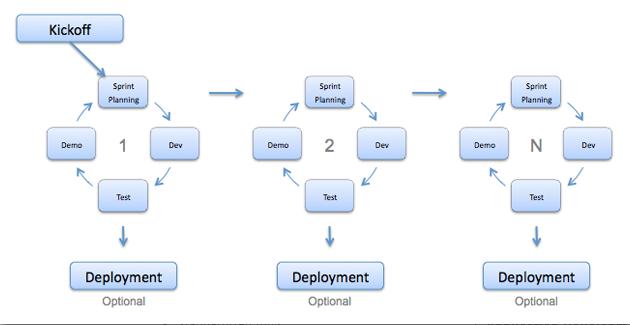What is Agile model – advantages, disadvantages and when to use it?
What is Agile model – advantages, disadvantages and when to use it?
http://istqbexamcertification.com/what-is-agile-model-advantages-disadvantages-and-when-to-use-it/
863
115 123
Agile development model is also a type ofIncremental model. Software is developed in incremental, rapid cycles. This results in small incremental releases with each release building on previous functionality. Each release is thoroughlytested to ensure software quality is maintained. It is used for time critical applications. Extreme Programming (XP) is currently one of the most well known agile development life cycle model.
Diagram of Agile model:

Advantages of Agile model:
- Customer satisfaction by rapid, continuous delivery of useful software.
- People and interactions are emphasized rather than process and tools. Customers, developers and testers constantly interact with each other.
- Working software is delivered frequently (weeks rather than months).
- Face-to-face conversation is the best form of communication.
- Close, daily cooperation between business people and developers.
- Continuous attention to technical excellence and good design.
- Regular adaptation to changing circumstances.
- Even late changes in requirements are welcomed
Disadvantages of Agile model:
- In case of some software deliverables, especially the large ones, it is difficult to assess the effort required at the beginning of the software development life cycle.
- There is lack of emphasis on necessary designing and documentation.
- The project can easily get taken off track if the customer representative is not clear what final outcome that they want.
- Only senior programmers are capable of taking the kind of decisions required during the development process. Hence it has no place for newbie programmers, unless combined with experienced resources.
When to use Agile model:
- When new changes are needed to be implemented. The freedom agile gives to change is very important. New changes can be implemented at very little cost because of the frequency of new increments that are produced.
- To implement a new feature the developers need to lose only the work of a few days, or even only hours, to roll back and implement it.
- Unlike the waterfall model in agile model very limited planning is required to get started with the project. Agile assumes that the end users’ needs are ever changing in a dynamic business and IT world. Changes can be discussed and features can be newly effected or removed based on feedback. This effectively gives the customer the finished system they want or need.
- Both system developers and stakeholders alike, find they also get more freedom of time and options than if the software was developed in a more rigid sequential way. Having options gives them the ability to leave important decisions until more or better data or even entire hosting programs are available; meaning the project can continue to move forward without fear of reaching a sudden standstill.
You can refer to our introduction to Agile Methodology if you would like to understand Agile better however, the above information is sufficient for the ISTQB Foundation Level exam.
Other models you may want to study:

Comments
Post a Comment